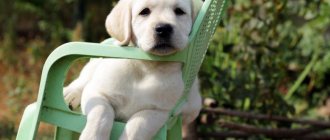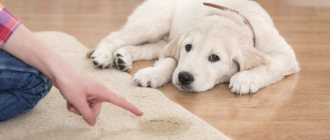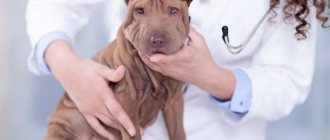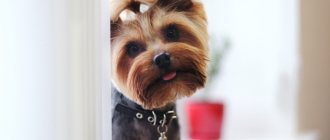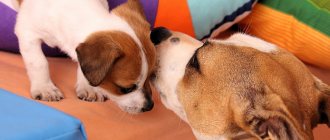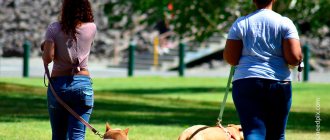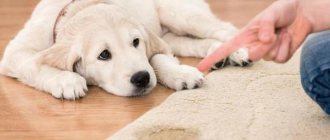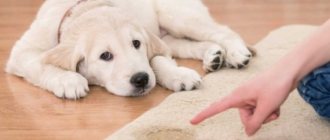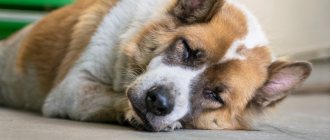Getting a dog is a very important step, somewhat similar to the decision to have a child. A puppy grows up faster, but it goes through all stages of development, just like your own baby. He will need to learn the norms and rules of behavior, get used to the feeding and walking routine. And the most painful question that dog trainers and breeders are often asked: when does a puppy stop peeing at home?
Day mode
In a puppy under 6 months of age, the bladder muscles are still very weak. They physically cannot endure for long. Therefore, leaving your baby at home all day and scolding him for puddles is not very wise on your part. Before asking when a puppy stops peeing at home, try to think about how much time you are willing to dedicate to raising him. If you are too busy, then do not take on additional responsibility for the life and health of the dog.
Polydipsia
Often the reason that a dog urinates frequently and a lot is due to a condition called polydipsia. It can be recognized due to the fact that the animal drinks a huge amount of water, several times exceeding all permissible norms. If the liquid is abused by a female individual, it is reasonable to suspect the presence of pyometra.
You can't do without an ultrasound here. Avoid self-medication. Only a doctor should recommend medications.
Polydipsia is an alarming symptom. And the most important thing is that the fear is not that the dog often urinates and drinks a lot, but what is hidden behind this. And we can talk here about many serious diseases:
- diabetes mellitus;
- genitourinary infection;
- renal failure.
Not for an owl
So, from the moment the puppy appears in the house until he reaches 6 months, you need to rearrange your daily routine in such a way as to walk him at least four times a day. The first departure is early in the morning, at about 5-6 o'clock. After this, you will have enough time to do your usual chores and get ready for work. Be sure to take another walk before leaving. This will make it easier for the puppy to endure.
Lunch break should be an occasion to look home. By going outside for just 15 minutes, you will provide your baby with the opportunity to wait until the evening without unnecessary discomfort. And after dinner you need to devote at least 2-3 hours to a walk.
Cystitis
Often with this pathology, the dog urinates frequently. How to treat it? First of all, you need to pass all the necessary tests. The doctor will prescribe them. When a dog has severe inflammation, this is usually accompanied by leakage of urine. Your pet may also defecate during sleep.
Hypothermia usually leads to cystitis. And therapeutic measures to get rid of the pathology involve taking antibiotics. As soon as the dog starts taking them, improvements will be noticeable and this happens almost immediately.
A full course of therapy is required, and in severe cases more than one. It is impossible to quit treatment halfway, as the disease may re-develop. And don’t be fooled by the cessation of all symptoms.
By the way, know that if a dog often urinates with blood, then this is one of the main signs of cystitis. And not in its first stage, but in a fairly advanced stage.
Your behavior
Of course, every owner eagerly awaits the moment when the puppy stops peeing at home. But you shouldn’t express your frustration too much if he doesn’t yet demonstrate the desired behavior. And even more so punish him if he peed in the wrong place. By doing this, you will achieve only one thing: the pet will more carefully choose places to relieve itself, climb onto the sofa or onto the bed. Upholstered furniture quickly absorbs the puddle, and the “traces of the crime” will be hidden. For now, of course.
This is what teenagers do when their owners try to “educate” them, because they are already more intelligent. The puppy will not understand at all why you are scolding him. Therefore, you should forget about slippers on the butt or poking your face into a puddle. This will not achieve anything, but you will lose contact. Give a noise signal instead. That is, throw something that rings or just clap your hands.
Main reasons
The main reasons that force a pet to relieve itself outside the toilet include inherited predisposition and health difficulties. Often the reasons are:
- lack of regime;
- lost authority of the owner;
- jealousy;
- little attention;
- Uncleanliness (caused by lack of exercise).
Let's look at each cause and solution in more detail. Dogs that do not follow a specific daily routine are unable to develop permanent habits. Dogs simply do not develop the appropriate reflexes. Therefore, walks and meals are prescribed at set times. If we talk about lost authority, perhaps there is revenge for unfair punishment or aggression of the owner towards the animal. In the process of training or other circumstances, the animal felt the possibility of its own impunity, the owner’s too kind attitude. More aggressive representatives, seeking to dominate the pack, begin to show open hostility, while other, more peaceful dogs are able to relieve themselves at home.
Review your behavior. Perhaps you pamper the dog too much, allow too much, or you simply became afraid, perhaps the animal snapped during the training process.
In the absence of attention, adult individuals sometimes try to return human participation by choosing such an ugly method. It is worth analyzing your own behavior and correcting mistakes. This is how individuals who are jealous of the owner of a new representative of the fauna show dissatisfaction.
What do we have to do
If there is a clearly thought out scheme, then acting on it is much easier. After all, if you just dream about those days when the puppy stops peeing at home, it won’t make them come any faster. You can proceed as follows. In almost all apartments, the toilet is located close to the front door. Therefore, we slowly move the puppy’s tray to the toilet and teach him how to use it. The door should be left ajar so that the baby can push it with his paw. When this moment passes, the door closes.
Then everything depends on you. As soon as the puppy gives a signal that he wants to go to the toilet, that is, he pushes the door with his paw, you grab the leash and run out into the street with him. You can’t wait long, so if it’s not frosty outside, try to act quickly. Of course, you will have to constantly take time off from your work, but you just need to get through this period.
How to teach a puppy to be clean - frequent walks
Frequent walks are an important step in teaching your puppy to be clean. Before you teach your puppy to be clean, do everything possible to ensure that you have as much free time as possible in the first months of his life. If you have the opportunity to go outside with your puppy every 1.5-2 hours, that’s great. The dog is growing and therefore the metabolism in its body is quite fast, as a result of which the bladder and rectum are filled in a short time. If you do not live on the ground floor, taking walks often is quite problematic, but you should still try to do it. On the street, give the puppy the opportunity to calmly walk or run, smell and look at everything, before recovering, he needs to explore a suitable place and concentrate. Some novice dog breeders make the mistake of taking the puppy home immediately after he has completed all the necessary actions. Next time he will definitely try to endure until the end in order to extend the walk, and he will definitely leave everything else for later, that is, he will do it at home.
Never play with your puppy or allow him to play with other puppies or dogs until he has gone to the toilet.
When to expect relief
In fact, a dog grows up very quickly. Therefore, the moment when puppies stop peeing in the apartment is not far off. Any dog begins to easily adhere to your schedule at the age of 6-7 months. But until this age you need to keep an eye on her and “catch her.” It's simple, not complicated or time consuming. You just need to take the puppy outside at least once every 3 hours. Or, if you decide to train him to the tray first, put him in the designated area as soon as he wakes up or has eaten a hearty meal. Likewise at night, if he woke up and began to caress.
Symptoms of urinary incontinence
Incontinence can appear suddenly, but in most cases the “phenomenon” goes away along with the disease that caused it. You should contact your veterinarian if you observe the following signs:
- There are wet spots under the dog when he gets up, especially after a night's sleep.
- Wet fur in the riding breeches area, especially in adult dogs.
- The dog is constantly licking itself.
- Irritation of the skin in the genital area, visually similar to a mild burn.
- There is a smell of urine in the home, especially near the dog’s bed.
Physiological features
It happens that a puppy gets so used to doing “his business” at home that he refuses to go to the toilet outside. He happily walks on the playground, and then runs home to his diaper. The owners are horrified and rush to call the breeder or familiar dog breeders. There is only one question: at what age will a puppy stop peeing at home?
The owner needs to remember that he is the one in charge of the process. You shouldn’t blame everything on your pet: if he continues to urinate in the corners, then it’s your fault. Sometimes a few days are enough in which you devote all your attention to your pet, and the toilet issue will stop worrying you once and for all. And sometimes even one praise will be decisive.
Typically, a healthy puppy will empty its bladder immediately after waking up, and its bowels within 15 minutes of feeding. These rules must be followed during training. Don’t waste time and take your pet outside or to the litter tray on time.
Presence of deviations
Treating the disease we describe is not easy. Because there is a relationship with congenital or acquired problems, which are characterized by weakness of the urethral muscles. And if this is so, then urine will leak regularly. Treatment will not help completely.
What to do in the described situation? To begin with, do not panic, consult a specialist. He will tell you what to do. Indeed, in some cases, chronic diseases can be controlled, especially if they are detected in the initial stages.
Recommendations for training
When your pet is 2 months old, the most difficult period is over. Now he becomes more intelligent and tries to assimilate norms and rules, especially if this is supported by praise. A happy moment will soon come when the puppy stops peeing frequently at home. Now reducing the number of “misses” depends only on you. If you are watching TV and the puppy starts to spin around and look for a place, urgently put him in the tray or run outside. Then every day he will become more and more accustomed to the fact that he can relieve himself only in the place designated for this.
Place, by the way, is also of great importance. Remember how at home a corner in the bathroom was allocated for him, which was covered with a diaper? It is advisable to do the same on the street. Always sit your pet in one place, perhaps he will have the opportunity to sniff old puddles or piles. When planting him on the ground, give one command each time. Come up with it yourself, the wording doesn’t matter here. And praise when the process is completed.
Chemicals
Special preparations have been developed to stop dogs from fouling in the house. For example, behavioral spray. The product absorbs organic compounds left by the animal and causes a lasting disgust in it. At the same time, people do not feel an unpleasant odor.
However, this method has a significant drawback - dog breeders often complain that they do not get the expected effect, and it is impossible to wean a dog from writing at home. It is difficult to say what the outcome will be in one case or another.
If the problem returns
It also happens. The breeder informs the owner of the approximate time frame at which the puppy stops peeing at home. This is usually closer to 6 months of age. But sometimes after a while the owner is faced with the fact that puddles and piles begin to appear again. If we are talking about a young dog, then the problem is most likely psychological in nature:
- Excessively strong emotions. When a dog is happy to meet its beloved owner, it may wet itself. Or she is afraid of punishment for the trick. If people yell at a dog and beat it for mischief, it will do more mischief.
- The reason may also be longing for the owner. Experiments were conducted when cameras were installed in the homes of puppy owners who complained about such problems. As a result, it was possible to see that when the owners are at home, the dog behaves perfectly. She asks to go to the toilet, she is calm and happy. But as soon as they leave, she begins to rush and howl. Sometimes, unable to withstand the melancholy, she relieves herself and nervously gnaws on things.
- Problems of master's authority. A young dog may tend to be dominant. And if the owner demonstrates excessive gentleness, then the pet feels unpunished.
It happens that several months of training go to waste, and, at first glance, it is not clear why. The puppy stopped peeing on the diaper or the teenager began to relieve himself in the corners - pay attention to the points listed above. Perhaps the problem can be solved quite simply.
Training a Dog to Stop Submissive Urination
As your dog ages, he will outgrow the urge to urinate submissively. Training dogs at a young age can help them learn faster.
Dogs usually cower or drop to their feet when they feel the urge to submissively urinate.
They can also:
- Raise your front paws
- Press your tail
- Press your ears back
- Lick
If you notice your dog acting this way, redirect his attention immediately.
Consult your doctor
Sometimes the problem lies in your pet's physiology. For example, a female dog may continue to pee periodically at home until she is two years old. This is due to the formation of the hormonal system. Periodically, the dog begins to leave a number of small puddles. This is a phenomenon that goes away after the first birth or with age. It occurs, according to statistics, in one out of 5-7 females. If the problem appears in a young dog that has been trained to relieve itself on the street, then pay attention to the following factors:
- In cold weather, a dog can catch a cold. This leads to various kinds of inflammatory processes. It is possible that increased urination is a consequence of this.
- Jealousy. If the family has a child, a cat or another dog, then your pet may simply start leaving puddles out of jealousy. Or maybe mark the territory, showing the “newcomers” who is boss in this house.
- Severe stress.
As you can see, the question of how many months a puppy stops peeing at home remains open: there are too many nuances here. But normally this happens at 6-7 months.
Why did an adult dog start shitting at home?
It is very difficult to give a definite answer to the question - why does an adult dog shit at home . There are probably as many reasons for this phenomenon as there are pets peeing on the carpet. And before solving the problem, it is necessary to understand what its background is.
The main types of problems are physiological or psychological. Each variant has several dozen subspecies. The main versions are presented below, but if nothing helps, you need to contact a zoopsychologist who will help you understand the specific problem.
Physiological ailments
Health problems are often the result of unpleasant surprises at home. In certain situations, the dog simply cannot wait to go for a walk.
The main physiological reasons that lead to incontinence in dogs:
- Internal organ injuries.
- Inflammation of the bladder (cystitis).
- Kidney diseases.
- Problems with the gastrointestinal tract.
- Side effects of medications.
- Overdose of veterinary drugs.
- Hypothermia.
- Viral infections.
- Age.
You can get rid of bowel movements in the house by carefully analyzing the situation. If there is even the slightest suspicion of physiology, it is necessary to urgently contact a veterinary clinic. Carry out all the necessary procedures to identify the factor that led to bowel movements in the apartment. After eliminating the root cause, the effect will disappear on its own.
Psychological abnormalities
Anything related to psychological characteristics is much more difficult to correct. You need to very carefully delve into the delicate soul of a dog.
The main psychological factors why a dog craps at home:
- Fear, phobias.
- Substrate habit.
- Diffidence.
- Too much time without walking.
- Demand for attention.
- Change of usual environment (can be attributed to stress).
- Experienced stress.
- An uncorrected habit of walking indoors since puppyhood.
All problems can be dealt with only by finding out the real reason for the manifestation of destructive behavior. The main obstacle in this situation is that it is impossible to know exactly how the pet behaves in the absence of its owners, and this is very important. In the age of high technology, nothing is impossible anymore - you can leave the camera and watch what happens when the dog is left alone.
Occurrence of diseases
Why does my dog urinate frequently? What to do in this case? Let's look at this question in more detail. Often this phenomenon indicates the presence of certain diseases, usually of inflammatory etiology. Identifying the causes is not easy, even with diagnostics. What to do?
Write down all manifestations of urinary incontinence, be sure to mention under what conditions it occurs. Also describe the dog’s menu, the number of walks per day, and, of course, do not forget about the amount of liquid your pet drinks. The more information you give your veterinarian, the easier it will be for him to understand the problem.
How to determine diabetes insipidus?
This disease is diagnosed by thirst and a large amount of urine produced. Sometimes urinary incontinence occurs, which is associated with the inability of the animal to empty its bladder for reasons beyond its control.
Differential diagnosis of diabetes insipidus is carried out together with other pathologies:
- hypercorcetism;
- true diabetes mellitus;
- hypercalcemia;
- pyometra;
- renal failure;
- liver diseases;
- pyelonephritis;
- psychogenic polydipsia.
Laboratory tests for this pathology usually look like this:
- UAC is the norm.
- Blood biochemistry - no changes, rarely increased sodium content.
- The density of urine - with the pathology we describe, it is low, approximately 1009-1013. Its color is almost like water or faint staining.
- Blood serum - the amount of ADH is determined.
- Test with exclusion of fluid or administration of chemical ADH, if central diabetes insipidus is suspected. If the animal's desire to drink decreases and its density increases, this confirms the diagnosis.
- MRI or TM if a pineal tumor is suspected.
Before conducting tests with ADH, the doctor must exclude all other possible causes of this condition. Since these studies are carried out only in the clinic due to the possibility of dehydration.
